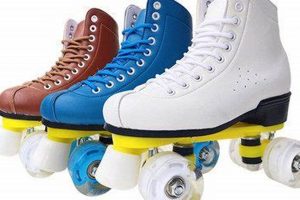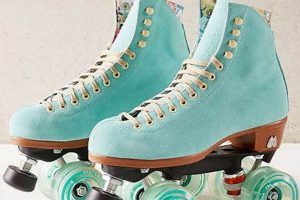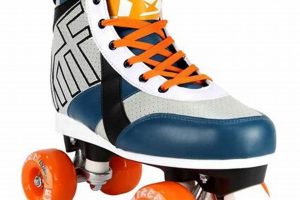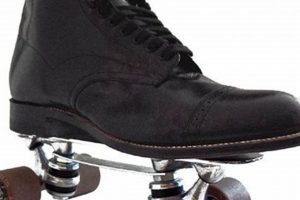Equipment designed for young athletes participating in the physically demanding sport of roller derby is crucial. These specialized boots, mounted on a plate with wheels, facilitate the unique movements and agility required on the track. Constructed with durable materials to withstand rigorous use, these sets often incorporate features like reinforced ankle support and responsive wheel setups, enabling young skaters to develop their skills effectively.
The proper equipment plays a vital role in the safety and performance of young roller derby participants. Well-fitting and quality items contribute to increased stability and maneuverability, reducing the risk of injuries during practice and competition. Historically, the development of specialized gear has mirrored the evolution of the sport itself, with continuous improvements focused on enhancing both protection and athletic capability.
The following sections will delve deeper into the components, fitting considerations, and maintenance practices essential for selecting appropriate equipment for young athletes in this fast-paced and exciting sport. Emphasis will be given to ensuring a safe and positive introduction to roller derby for developing skaters.
Equipment Guidance for Young Roller Derby Athletes
The selection of appropriate equipment for young participants in roller derby is paramount. The following tips offer guidance for ensuring safety and optimizing performance.
Tip 1: Prioritize Proper Fit: Accurate sizing is crucial for comfort and control. Consult sizing charts provided by manufacturers and, ideally, seek professional fitting assistance at a reputable skate shop.
Tip 2: Assess Ankle Support: Adequate ankle support minimizes the risk of sprains and strains. Look for models with reinforced ankle padding and secure lacing systems that provide a snug, supportive fit.
Tip 3: Evaluate Wheel Durometer: Wheel durometer (hardness) affects grip and roll. Softer wheels offer more grip, while harder wheels roll faster. Consider the skating surface and the skater’s skill level when selecting wheel durometer.
Tip 4: Inspect Plate Material: The plate (the chassis connecting the boot to the wheels) material influences responsiveness. Aluminum plates are generally lighter and more responsive than nylon or plastic plates, but may be more expensive.
Tip 5: Consider Bearing Quality: Bearing quality impacts roll efficiency. Higher-quality bearings offer smoother and faster rolling, requiring less effort from the skater. ABEC ratings indicate bearing precision, with higher numbers generally signifying greater accuracy.
Tip 6: Regular Maintenance is Essential: Consistent cleaning and maintenance are crucial to prolong equipment lifespan and maximize performance. Regularly check and tighten all nuts and bolts, clean bearings, and replace worn wheels promptly.
Tip 7: Prioritize Safety Gear: Helmets, elbow pads, knee pads, wrist guards, and mouthguards are non-negotiable for all roller derby participants. Ensure that safety gear fits properly and meets relevant safety standards.
Adhering to these guidelines contributes to a safer and more enjoyable roller derby experience for young athletes, fostering skill development and promoting long-term participation.
The subsequent sections will elaborate on specific equipment components and provide additional insights into optimizing performance and ensuring athlete well-being.
1. Proper Boot Fitting
Proper boot fitting constitutes a foundational element in equipping young athletes for roller derby. The interface between the skater’s foot and the boot directly influences stability, control, and injury prevention. A well-fitted boot optimizes energy transfer, allowing for efficient execution of derby maneuvers.
- Accurate Foot Measurement
Precise measurement of foot length and width is the initial step. Deviations from standard shoe sizes are common, necessitating the use of sizing charts specific to the skate manufacturer. A foot tracing can aid in determining the correct width. Inaccurate measurements can lead to discomfort, blisters, and compromised performance.
- Snug Heel Retention
Proper heel retention prevents slippage within the boot. Excessive heel movement diminishes power transfer and increases the likelihood of blisters and ankle instability. Lacing techniques, such as heel-lock lacing, can enhance heel retention. Boots with adjustable heel cups offer a customized fit. A secure heel minimizes extraneous motion during quick stops and directional changes.
- Appropriate Toe Box Space
The toe box should provide sufficient space for toes to move freely without being cramped. Overly tight toe boxes can lead to numbness, discomfort, and potentially long-term foot deformities. A thumb’s width of space between the longest toe and the end of the boot is a common guideline. Avoid boots with excessive toe room, as this can compromise control.
- Arch Support Considerations
Arch support influences foot alignment and stability. Individuals with high or low arches may require custom orthotics or specialized insoles to provide adequate support. Insufficient arch support can lead to foot fatigue and pain. Consult with a podiatrist or skate fitter to assess arch type and recommend appropriate support solutions. Proper arch support contributes to a balanced and stable skating posture.
These facets underscore the importance of meticulous boot fitting for young roller derby athletes. A properly fitted boot maximizes performance, enhances comfort, and reduces the risk of injuries, contributing to a positive and sustainable roller derby experience. Neglecting these details can hinder skill development and potentially compromise the skater’s well-being.
2. Ankle Support Strength
Ankle support strength in youth roller derby skates is a critical factor influencing athlete safety and performance. Insufficient support can lead to instability, increasing the risk of ankle sprains and other injuries. Adequate support enhances stability, allowing for more controlled movements and more powerful skating.
- Boot Height and Stiffness
Higher boot heights generally provide greater ankle support by restricting range of motion. Stiffer boot materials, such as reinforced leather or composite synthetics, further enhance support by limiting lateral movement. However, excessively stiff boots can restrict agility. The ideal boot strikes a balance between support and mobility. For example, a boot extending slightly above the ankle bone with moderate stiffness could be appropriate for developing skaters.
- Lacing System and Closure Mechanisms
The lacing system plays a crucial role in securing the ankle within the boot. Lacing patterns that extend high up the ankle and incorporate features like power straps or Velcro closures offer enhanced support. These systems allow skaters to customize the tightness and level of support based on individual needs and preferences. A poorly designed lacing system can result in inadequate support, even with a high boot height.
- Internal Padding and Reinforcement
Internal padding and reinforcement around the ankle contribute significantly to both comfort and support. Strategically placed padding cushions the ankle and minimizes pressure points. Reinforcement materials, such as plastic or carbon fiber inserts, add structural integrity and limit ankle flexion. Insufficient padding can lead to discomfort and blistering, while inadequate reinforcement compromises stability.
- Heel Counter Stability
The heel counter, the rigid structure at the back of the boot that cups the heel, directly influences ankle stability. A sturdy heel counter prevents excessive pronation or supination of the foot, reducing the risk of ankle injuries. A flimsy or poorly constructed heel counter can compromise ankle support, even if other aspects of the boot are well-designed. A well-defined and robust heel counter is essential for maintaining proper foot and ankle alignment.
These integrated features of ankle support strength in youth roller derby skates contribute to a stable and secure skating platform. Selecting skates with appropriate ankle support, based on the skater’s skill level and physical needs, is paramount for promoting safe and effective participation in roller derby. Prioritizing this aspect minimizes the risk of injury and maximizes the potential for athletic development.
3. Wheel Durometer Choice
Wheel durometer selection directly impacts the performance and safety of young roller derby athletes. Durometer, measured on the A scale, signifies wheel hardness; lower numbers indicate softer wheels, while higher numbers denote harder ones. The optimal durometer depends on factors such as skating surface, skater weight, and skill level, influencing grip, roll speed, and maneuverability.
- Grip versus Roll Trade-off
Softer wheels (e.g., 88A-92A) offer increased grip, particularly beneficial on slick or uneven surfaces. This enhanced grip allows for quicker stops and more controlled turns, vital for novice skaters. However, softer wheels exhibit slower roll speeds and require more effort to maintain momentum. Conversely, harder wheels (e.g., 95A-101A) provide faster roll speeds, enabling greater acceleration and sustained velocity on smooth surfaces. The trade-off is reduced grip, potentially compromising control for less experienced skaters. The surface on which skaters will be practicing and competing should influence this important decision.
- Surface Condition Adaptation
Wheel durometer should be adjusted to match the skating surface. Softer wheels perform optimally on concrete or wood floors with imperfections, providing the necessary grip to compensate for unevenness. Harder wheels are better suited for polished surfaces, such as those found in dedicated skating arenas, where their superior roll speed can be fully realized. Using excessively hard wheels on rough surfaces can lead to a jarring ride and diminished control, while employing overly soft wheels on smooth surfaces can result in excessive drag and premature wear.
- Skater Weight and Style Influence
Heavier skaters generally benefit from harder wheels, which provide greater support and prevent excessive compression. Lighter skaters may find softer wheels more suitable, as they require less force to engage the wheel’s grip. Skating style also plays a role; skaters who prioritize agility and quick stops may prefer softer wheels, while those who emphasize speed and long-distance skating may opt for harder wheels. A jammer, for example, might choose a durometer that balances speed and agility, while a blocker may prefer a durometer that prioritizes stability and control.
- Wheel Wear and Longevity
Softer wheels tend to wear down more quickly than harder wheels, particularly on abrasive surfaces. Harder wheels, while more durable, can develop flat spots or chipping over time, compromising performance. Regular rotation of wheels helps to distribute wear evenly and prolong their lifespan. Replacing worn wheels promptly is essential for maintaining optimal grip and roll characteristics, ensuring consistent performance and minimizing the risk of accidents. Monitoring wheel wear patterns can also provide insights into skating technique and potential areas for improvement.
The selection of an appropriate wheel durometer for youth roller derby skates requires careful consideration of multiple factors. Balancing grip and roll, adapting to surface conditions, accounting for skater weight and style, and monitoring wheel wear are crucial for optimizing performance and ensuring a safe and enjoyable skating experience. Proper wheel durometer choice allows young athletes to develop their skills effectively and confidently.
4. Plate Material Composition
The material composition of the skate plate is a crucial determinant of performance characteristics in equipment intended for young roller derby athletes. The plate directly connects the boot to the wheels and transmits force during skating, influencing responsiveness, agility, and overall durability. Understanding the properties of different plate materials is essential for selecting suitable skates.
- Aluminum Alloys
Aluminum alloys are frequently employed in higher-end youth roller derby skates due to their favorable strength-to-weight ratio. Aluminum plates offer enhanced responsiveness, allowing skaters to execute quick turns and accelerate rapidly. Specific alloys, such as 7075 aluminum, provide increased strength and resistance to bending under stress. Examples include plates with reinforced stress points to withstand the demands of competitive derby. The use of aluminum alloys directly improves maneuverability and control.
- Nylon and Composite Polymers
Nylon or composite polymer plates represent a more cost-effective option, often found in entry-level youth skates. These materials offer greater flexibility compared to aluminum, which can be advantageous for skaters still developing their technique. However, nylon plates generally exhibit lower strength and reduced responsiveness. For example, a skater may find it more difficult to achieve the same level of power transfer as with an aluminum plate. While more forgiving, nylon plates might not withstand the same level of impact or stress over time.
- Truck and Kingpin Materials
The materials used in the trucks (the part that houses the axle and wheels) and kingpins (the central bolt that connects the truck to the plate) also contribute to the plate’s overall performance. Steel trucks and kingpins are common due to their durability and resistance to wear. However, some manufacturers utilize lighter materials, such as titanium or aluminum, to reduce weight and improve responsiveness. The choice of material affects the turning radius and stability of the skate, influencing the skater’s ability to navigate the track effectively.
- Plate Mounting and Design
The way the plate is mounted to the boot and the overall plate design also influence performance. A properly mounted plate ensures optimal force transfer and prevents unwanted flex or movement. Different plate designs, such as those with adjustable pivot points, allow skaters to customize the skate’s handling characteristics. The plate’s angle relative to the boot also affects stability and maneuverability. A well-designed and properly mounted plate enhances both comfort and performance, contributing to a positive skating experience for young athletes.
In summary, the selection of appropriate plate material composition for youth roller derby skates is a critical decision, impacting performance, durability, and cost. Aluminum alloys offer superior responsiveness for experienced skaters, while nylon or composite polymers provide a more forgiving option for beginners. The materials used in the trucks and kingpins, along with the plate mounting and design, further refine the skate’s handling characteristics. Carefully considering these factors ensures young athletes have equipment suited to their skill level and skating style.
5. Bearing Precision Standards
Bearing precision standards, primarily defined by the Annular Bearing Engineering Committee (ABEC) scale, directly influence the performance characteristics of youth roller derby skates. The ABEC rating, ranging from ABEC 1 to ABEC 9, quantifies the manufacturing tolerances of the bearing’s internal components. Higher ABEC ratings indicate tighter tolerances, resulting in smoother and faster rotation. In youth roller derby, the choice of bearing precision can significantly affect a skater’s speed, agility, and overall skating efficiency. For instance, skates equipped with ABEC 5 or ABEC 7 bearings will generally provide a noticeable improvement in roll compared to skates with ABEC 1 or unrated bearings. This can translate to improved acceleration and the ability to maintain higher speeds on the track. However, higher ABEC ratings also typically correspond to increased cost, and the benefits may be less pronounced for beginner skaters.
The practical implications of understanding bearing precision extend beyond just speed and roll. Bearings with tighter tolerances tend to be more durable and require less maintenance, as they are less susceptible to contamination and wear. This can be particularly important in the demanding environment of roller derby, where skates are subjected to significant stress and impact. Consider a scenario where a young skater is consistently practicing aggressive skating maneuvers; skates with higher-precision bearings would likely withstand these forces better and maintain their performance longer than those with lower-rated bearings. Moreover, proper bearing maintenance, including cleaning and lubrication, is crucial to maximizing the lifespan and performance of bearings regardless of their ABEC rating. Neglecting maintenance can negate the benefits of even the highest-rated bearings.
In conclusion, bearing precision standards represent a critical component in the overall performance of skates designed for youth roller derby. While higher ABEC ratings generally equate to improved speed, durability, and reduced maintenance, the optimal choice depends on the skater’s skill level, skating style, and budget. A balanced approach that considers both bearing precision and proper maintenance practices is essential for ensuring a safe and rewarding skating experience. Challenges include balancing the cost with performance benefits and understanding the impact of external factors such as track conditions and skating technique. The practical significance lies in empowering skaters and their families to make informed decisions that contribute to enhanced performance and longevity of their equipment.
Frequently Asked Questions
This section addresses common inquiries regarding youth roller derby skates, aiming to provide clarity and informed decision-making for parents and young athletes.
Question 1: What constitutes an appropriate age range for youth roller derby skates?
Youth roller derby skates are typically designed for individuals aged 6 to 17. However, maturity level, skating experience, and physical development should be considered. Consultation with a skate professional or experienced coach is recommended to determine suitability.
Question 2: Are there specific safety certifications to look for when purchasing equipment?
While no single certification universally applies to all roller derby equipment, adherence to standards such as ASTM F1849 for recreational roller skates is advisable. Ensure protective gear (helmet, pads) meets relevant safety certifications (e.g., CPSC for helmets).
Question 3: How frequently should youth roller derby skates be replaced?
Replacement frequency depends on usage intensity, skater growth, and equipment wear. Regular inspection for damage is crucial. Signs of wear, such as boot separation, plate cracking, or bearing failure, necessitate replacement. Annually is a good rule to follow with the needs of skater.
Question 4: What is the recommended procedure for cleaning and maintaining youth roller derby skates?
After each use, wipe down boots and plates with a damp cloth. Regularly clean bearings using a solvent-based cleaner and re-lubricate with skate-specific oil. Inspect and tighten all nuts and bolts. Wheel rotation prolongs wheel lifespan.
Question 5: Is it necessary to purchase specialized youth roller derby skates, or can recreational skates suffice?
While recreational skates may be suitable for initial exposure, specialized roller derby skates offer enhanced ankle support, plate responsiveness, and wheel characteristics optimized for the sport’s demands. Upgrading to derby-specific skates is recommended as skill progresses.
Question 6: How does wheel durometer selection impact a young skater’s learning curve?
Softer wheels (lower durometer) provide increased grip, aiding beginners in developing fundamental skating skills. As skill improves, harder wheels (higher durometer) offer greater roll speed. Experimentation under experienced guidance helps determine the optimal durometer for individual style and surface conditions.
Proper selection and maintenance of roller derby skates significantly influence safety and performance for young athletes. Informed decisions contribute to a positive and sustainable sporting experience.
The following section will provide a conclusion to summarize the important points of youth roller derby skates.
Conclusion
The preceding analysis has thoroughly examined critical aspects of youth roller derby skates. Considerations ranging from boot fit and ankle support to wheel durometer and plate material composition influence skater safety and performance. The selection of equipment requires careful consideration of individual skater needs, skill level, and the specific demands of the sport. Precision standards for bearings further refine the skating experience, impacting both speed and efficiency.
Ensuring access to appropriate and well-maintained equipment represents a crucial investment in the well-being and development of young roller derby athletes. Prioritizing safety and performance considerations fosters a positive and sustainable involvement in this demanding sport. Continued research and technological advancements in skate design hold the potential to further enhance both safety and athletic potential.







